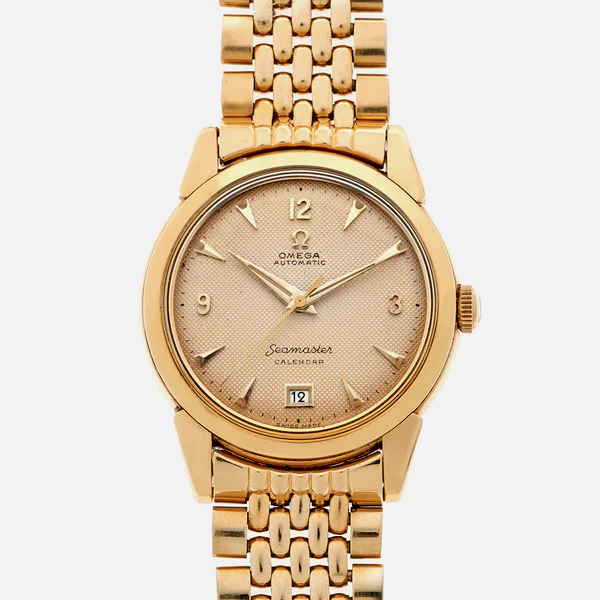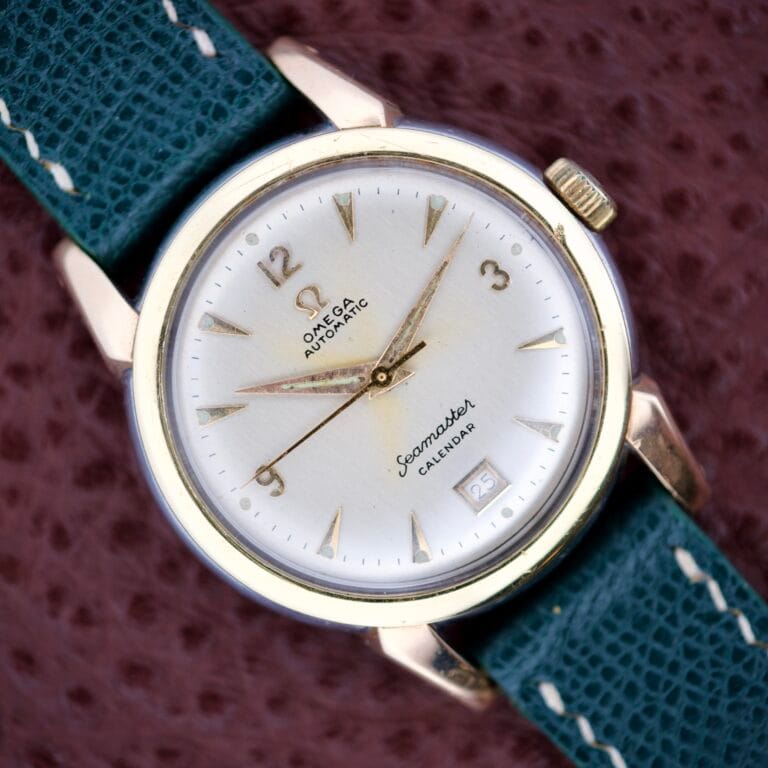Don't miss the next drop
Omega Seamaster 2627
Last updated: July 22, 2025

Brand:
Model Line:
Production Period:
1952-1955
Caliber/s:
Unconfirmed
Case Width:
34.5mm
Case Height:
43mm
Lug Width:
18mm
Omega Seamaster 2627 Description
The Omega Seamaster reference 2627, introduced circa 1952, holds a significant place in Omega’s history as the brand’s first wristwatch to feature a date complication displayed in an aperture on the dial. This model, part of the early Seamaster lineage, was typically powered by Omega’s “bumper” automatic movements, primarily the Caliber 353 and later the Caliber 355. The date window is characteristically located at the 6 o’clock position. The Seamaster 2627 was offered in various case materials, including stainless steel, gold-capped, and solid gold, and featured a diverse array of dial designs, with honeycomb/waffle textures being particularly sought after. A rare and notable variation includes a “Calender” (misspelled) dial. This reference represents a transitional period in watchmaking, blending everyday practicality with emerging luxury features.
Specifications
| Reference Number | 2627 (with suffixes like -4, -7SC, -11SC, C) |
| Production Year(s) | Circa 1952 – 1955 (based on movement production years) |
| Movement Caliber(s) | Omega Caliber 353 (Automatic Bumper, Date) <br> Omega Caliber 355 (Automatic Bumper, Date) |
| Movement Type | Automatic “Bumper” |
| Case Diameter | Approx. 34.5mm (excluding crown) |
| Case Material(s) | Stainless Steel, Gold-Capped (often 14k), Solid Gold (14k Yellow, 18k Pink, 18k Yellow) |
| Case Back | Smooth outer case back (pre-Hippocampus logo); Press-in or Screw-down depending on variant. |
| Dial Colors | Black, White/Silver, Champagne/Cream/Beige, Gold |
| Dial Textures | Honeycomb/Waffle, Enamel, Clous de Paris, Smooth/Satin/Matte |
| Hour Markers | Applied Dart/Arrowhead, Baton, “Shark Teeth”/”Home Plates”, Arabic Numerals (at quarters) |
| Hands | Dauphine (often lumed with Radium) |
| Date Window | At 6 o’clock; early versions rectangular, later trapezoidal. |
| Crystal | Acrylic (Plexiglass), sometimes Omega signed |
| Lug Width | 18mm |
| Water Resistance (Original) | Up to 30 meters / 3 bar for some variants (e.g., with screw-down crown). Not guaranteed today. |
| Lume | Radium |
Key Details & Variations
Variations
The Omega Seamaster 2627 series is notable for its numerous variations:
- Reference Suffixes: Suffixes like -4, -7SC, -11SC, and C likely denote specific case manufacturers, minor design updates, or market-specific adaptations. “SC” typically indicates “Seconde Centrale” (Central Seconds).
- Case Materials:
- Stainless Steel
- Gold-Capped: A thick layer of gold (often 14k) bonded to a steel base.
- Solid Gold: Available in 14k yellow gold, 18k pink gold, and 18k yellow gold.
- Dial Textures & Colors:
- Textures: Highly sought-after honeycomb/waffle patterns, enamel, Clous de Paris guilloché, and smoother satin or matte finishes.
- Colors: Black, white/silver, champagne/cream/beige, and gold.
- Hour Markers: Applied indices in styles such as dart/arrowhead, various baton shapes (including “Art Deco”), “shark teeth” or “home plates,” and occasionally Arabic numerals at the quarter hours.
- Date Window Shape: Early (1952) examples had a rectangular date window at 6 o’clock; from 1953, this evolved to a trapezoidal or 5-sided shape, sometimes with a gold frame.
- “Calender” Misprint: A rare and valuable variation features “CALENDER” misspelled on the dial.
Correct Dial
- Date Position: Consistently at 6 o’clock.
- Markings: Signed “Omega,” “Automatic,” and “Seamaster.” The term “Calendar” (or the rare misprint “Calender”) is also present. “SWISS MADE” typically at the 6 o’clock position.
- Lume: Original lume was Radium, applied to hands and often as dots with hour markers.
- Crosshairs: Optional crosshair patterns could be present.
Correct Hands
- Style: Predominantly Dauphine hands, matching the material of the indices (gold or steel).
- Lume: Often featured Radium infill.
Correct Case
- Shape and Dimensions: Typically 34.5mm to 35.5mm in diameter, with a lug width of 18mm. Thickness around 10.5mm to 11.5mm. Features like “lapidated” or “claw” lugs and sometimes a “stepped bezel” are noted.
- Case Back: Early models had smooth outer case backs (pre-dating the Hippocampus logo). The inside is marked with the reference number (e.g., 2627-4). Some variants, like the 2627-7SC, featured a screw-down case back.
- Crown: Original Omega-signed crown, with styles including “flat foot,” “bowler,” or “clover” shapes. Some variants had screw-down crowns contributing to water resistance.
Additional Relevant Details
- Caliber 353:
- 17 jewels, 19,800 vph, approx. 42-hour power reserve.
- Features: Sweep seconds, date, shock protection, anti-magnetic.
- Production: 1949-1953 (or slightly beyond 1955 according to one source).
- Caliber 355:
- 17 jewels, 19,800 vph, approx. 42-hour power reserve.
- Features: Sweep seconds, date, Incabloc shock protection, often a swan-neck micrometer regulator.
- Production: 1953-1955.
- Mechanism: Both are “bumper” automatics, where a weighted rotor oscillates in a limited arc, “bumping” off buffer springs to wind the mainspring. This creates a distinct tactile sensation.
- Date Setting: Non-quickset; the date is advanced by moving the hands through 24-hour cycles.
Original crystals were acrylic (Plexiglass), sometimes featuring a tiny, centrally etched Omega logo.
The Seamaster 2627 is a desirable vintage Omega due to its historical status as the first Omega with a date window and the charm of its bumper movement and 1950s aesthetics.
- Value Drivers: Condition (unpolished cases, original dials), originality of all parts, dial rarity (honeycomb, “Calender” misprint), and case material (solid gold commands higher prices, but rare steel versions with exceptional dials are also valuable).
- Price Range: Varies widely. Gold-capped examples can be found from around $900 to $1,700, depending on condition and seller.
- The “bumper” movement itself contributes to a niche appeal among collectors who appreciate this transitional horological technology.
- Dial: Check for correct Omega fonts, logo application, “SWISS MADE” marking, and consistent aging of radium lume (dark patina).
- Case Markings: Inside case back should have reference 2627 (with suffix) and Omega signatures. Solid gold cases should have appropriate hallmarks.
- Movement: Verify Caliber 353 or 355, Omega signatures, copper-colored finish, and period-correct serial number.
- Crown & Crystal: Period-correct signed Omega crown and potentially an Omega-signed crystal.
As an eBay Partner, we may be compensated if you make a purchase.

